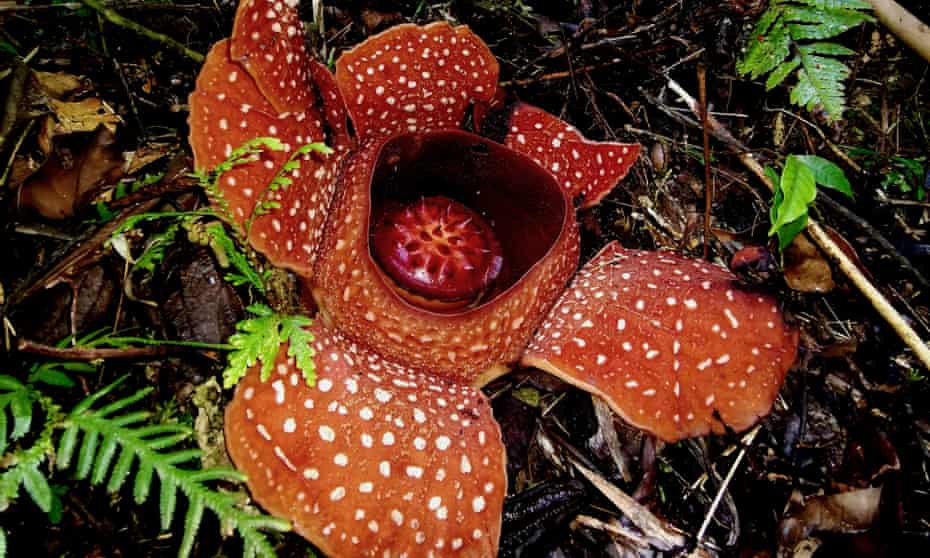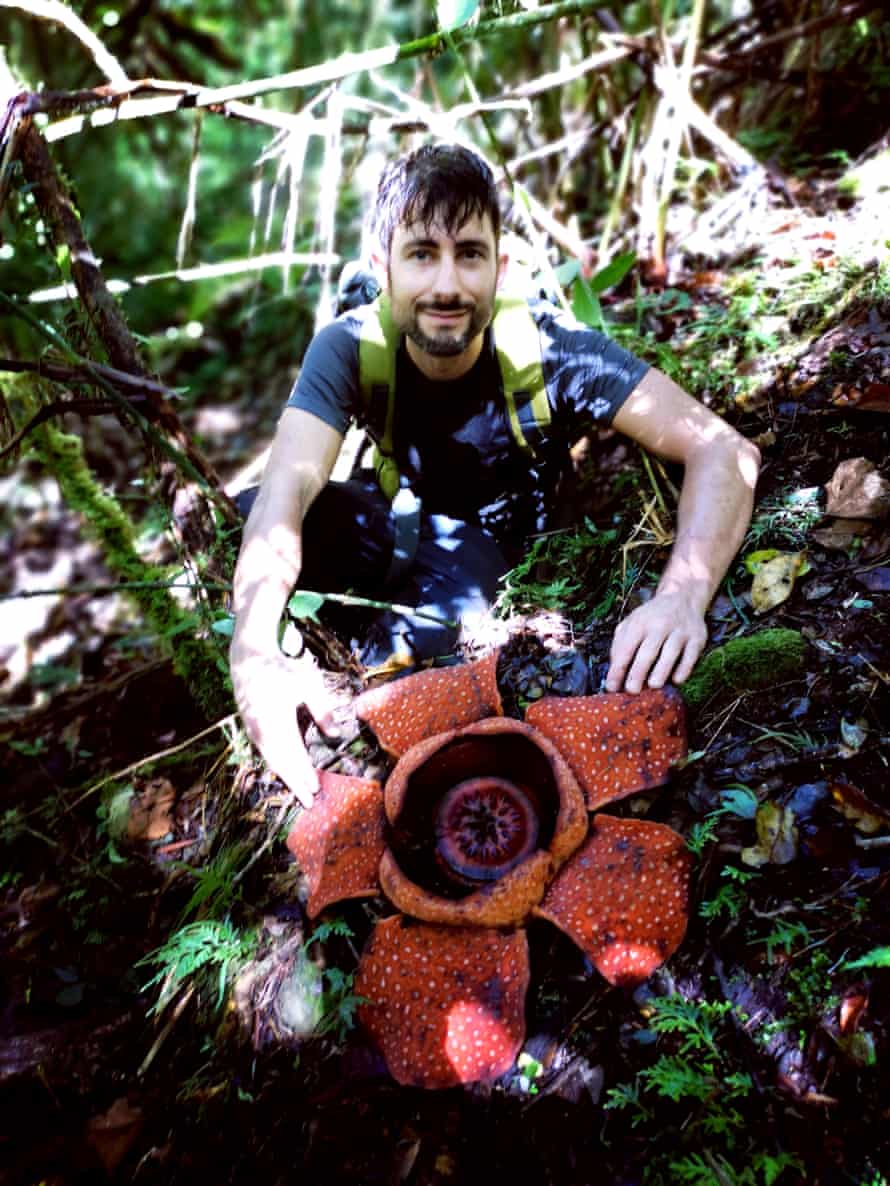Chris Thorogood had to venture deep into the Luzon rainforest to set eyes on the extraordinary Rafflesia banaoana
‘the world’s most whopping weird plant’



The Rafflesia banaoana flower, in the Luzon rainforest.
Photograph: Dr Chris Thorogood
Josh Halliday
Josh Halliday
Sun 27 Mar 2022
It was after travelling 6,600 miles and battling through the tropical assault course of the Luzon rainforest that Chris Thorogood set his eyes upon the rare and extraordinary flower that ignited his childhood imagination 30 years ago.
Thorogood, 38, last month became the first westerner to see the Rafflesia banaoana – an otherworldly-looking red spotted species that spans half a metre across – in an experience that reduced him to tears.
“It’s hard to put into words the feeling,” he said on Sunday. “It’s a combination of the exertion of the trek, which is quite intense, but also a feeling of sharing a moment with something ephemeral, rare, and a striking work of nature that you can’t see anywhere else. It’s a bit of a tear-jerker to sit with something like that.”
The Rafflesia banaoana is the rarest and most elusive species of the genus named after Sir Stamford Raffles, the founder of modern Singapore. The flowers are found only in the deep rainforests of Luzon island in the Philippines.
Thorogood, the deputy director of the Oxford Botanic Garden and Arboretum, describes it as “the world’s most whopping weird plant”.
The botanist is quick to point out that although he is the first westerner to set eyes on the Rafflesia, the experience would not have been possible without the work of Pastor Malabrigo Jr and Adriane Tobias, of the University of the Philippines, the only two other botanists to have seen the flower.
It was after travelling 6,600 miles and battling through the tropical assault course of the Luzon rainforest that Chris Thorogood set his eyes upon the rare and extraordinary flower that ignited his childhood imagination 30 years ago.
Thorogood, 38, last month became the first westerner to see the Rafflesia banaoana – an otherworldly-looking red spotted species that spans half a metre across – in an experience that reduced him to tears.
“It’s hard to put into words the feeling,” he said on Sunday. “It’s a combination of the exertion of the trek, which is quite intense, but also a feeling of sharing a moment with something ephemeral, rare, and a striking work of nature that you can’t see anywhere else. It’s a bit of a tear-jerker to sit with something like that.”
The Rafflesia banaoana is the rarest and most elusive species of the genus named after Sir Stamford Raffles, the founder of modern Singapore. The flowers are found only in the deep rainforests of Luzon island in the Philippines.
Thorogood, the deputy director of the Oxford Botanic Garden and Arboretum, describes it as “the world’s most whopping weird plant”.
The botanist is quick to point out that although he is the first westerner to set eyes on the Rafflesia, the experience would not have been possible without the work of Pastor Malabrigo Jr and Adriane Tobias, of the University of the Philippines, the only two other botanists to have seen the flower.

Chris Thorogood with ‘the world’s most whopping weird plant’.
Photograph: Dr Chris Thorogood
The trio gained permission to enter the farthest reaches of the rainforest by the indigenous Banao community, who own the land and escorted them to the flower by hacking a trail through the dense and hostile vegetation.
Advertisement
By the time they reached the Rafflesia, Thorogood’s arms were covered in blood from leeches and he nursed a plant sting that “felt like someone poured boiling water” on his skin.
The two-week expedition was the culmination of years of planning, but its genesis goes back to Thorogood’s childhood bedroom in Chelmsford, Essex. From the age of eight, he would marvel at photographs of alien species of rare flowers in the remotest corners of the planet.
“There were these extraordinary photographs of these flowers in the jungle somewhere that seems so remote and inaccessible and alien to me, as a child, having never really travelled very far,” he said.
“It’s almost like they were a magnet from the other side of the globe luring me to go and see them. I remember quite clearly as a child being entranced by these photographs in books of these otherworldly botanical enigmas. I think I subconsciously made my plans then that I was going to make it my life’s work to go and see them.”
Rafflesias can grow to 1.5 metres across and weigh 10kg, making them the largest flowers on earth. There are 13 species of Rafflesia in the Philippines and they remain something of a mystery in the scientific world.
Thorogood, the author of a book titled Weird Plants, said it was vital to understand rare species so they can be better protected.
“Two in three of the world’s plant species are threatened with extinction, which is alarming, and we’re losing plant species possibly more quickly than we can describe and discover them,” he said. “We can’t conserve or protect something if we don’t know it exists.”
As for his next expedition, Thorogood is remaining tight-lipped: “With 400,000 or so different plants, there’s a bewildering diversity of plants out there. So it’s very difficult to narrow it down to one or two. But there will be plenty of plants lying in wait for me, I’m sure.”
The trio gained permission to enter the farthest reaches of the rainforest by the indigenous Banao community, who own the land and escorted them to the flower by hacking a trail through the dense and hostile vegetation.
Advertisement
By the time they reached the Rafflesia, Thorogood’s arms were covered in blood from leeches and he nursed a plant sting that “felt like someone poured boiling water” on his skin.
The two-week expedition was the culmination of years of planning, but its genesis goes back to Thorogood’s childhood bedroom in Chelmsford, Essex. From the age of eight, he would marvel at photographs of alien species of rare flowers in the remotest corners of the planet.
“There were these extraordinary photographs of these flowers in the jungle somewhere that seems so remote and inaccessible and alien to me, as a child, having never really travelled very far,” he said.
“It’s almost like they were a magnet from the other side of the globe luring me to go and see them. I remember quite clearly as a child being entranced by these photographs in books of these otherworldly botanical enigmas. I think I subconsciously made my plans then that I was going to make it my life’s work to go and see them.”
Rafflesias can grow to 1.5 metres across and weigh 10kg, making them the largest flowers on earth. There are 13 species of Rafflesia in the Philippines and they remain something of a mystery in the scientific world.
Thorogood, the author of a book titled Weird Plants, said it was vital to understand rare species so they can be better protected.
“Two in three of the world’s plant species are threatened with extinction, which is alarming, and we’re losing plant species possibly more quickly than we can describe and discover them,” he said. “We can’t conserve or protect something if we don’t know it exists.”
As for his next expedition, Thorogood is remaining tight-lipped: “With 400,000 or so different plants, there’s a bewildering diversity of plants out there. So it’s very difficult to narrow it down to one or two. But there will be plenty of plants lying in wait for me, I’m sure.”
No comments:
Post a Comment